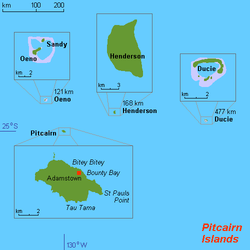|
Geography of the Pitcairn Islands
 The Pitcairn Islands are a group of four islands in the south Pacific Ocean: the group comprises Pitcairn Island (a volcanic island), Henderson Island (an uplifted coral island), and two coral atolls, Oeno Island and Ducie Island. The only inhabited island, Pitcairn, has an area of 5 km2 (1.9 sq mi) and a population density of 10/km2 (26/sq mi); it is only accessible by boat through Bounty Bay. The other islands are at a distance of more than 100 km (62 mi). Location The Pitcairn Islands as a group of islands in Oceania:(25°04′00″S 130°05′00″W / 25.06667°S 130.08333°W)
Situated in the South Pacific Ocean, about one-half of the way from Peru to New Zealand, they are one of the most remote sites of human habitation on Earth.[1][2] The only inhabited island, Pitcairn, is at 25.04 south, 130.06 west. Pitcairn is about 2,170 kilometres (1,350 mi) southeast of Tahiti, 5,310 kilometres (3,300 mi) from Auckland, New Zealand, and over 6,600 kilometres (4,100 mi) from Panama.[3] Area
Pitcairn Island is about 3.2 kilometres (2.0 mi) long and 1.6 kilometres (0.99 mi) wide.[3] This is about 3⁄10 of the size of Washington, DC. Land boundaries0 km (0 mi) Coastline51 km (32 mi) Maritime claimsExclusive economic zone:
836,000 km2 (323,000 sq mi)
ClimateThe Pitcairn Islands have a maritime tropical rainforest climate (Af according to the Köppen climate classification), with the climate being warm and humid year-round, with no dry season. The warmest month in Adamstown is February, with a mean of 23.8 °C (74.8 °F), while the coolest month is August, with a mean of 18.5 °C (65.3 °F). The highest temperature recorded was 33.3 °C (91.9 °F) during March. Because of its maritime location, the temperature has never dropped below 10 °C (50 °F). Adamstown receives 1,543 millimetres (60.7 in) of rainfall annually, with the rain being evenly distributed across the year. The climate of the Pitcairn Islands is modified by southeast trade winds.
Terrain The Pitcairn Islands have a rugged terrain caused by volcanic formation, with a rocky coastline and cliffs. Elevation extremesLowest point:
Pacific Ocean coastline 0 m (sea level)
Natural resourcesMiro trees (used for handicrafts), fish
Natural hazardsTropical Cyclones (especially November to May) Environment – current issuesDeforestation (only a small portion of the original forest remains because of burning and clearing for settlement) MapsWorldwide map services show very little detail of the islands, and are even of limited use to show the location of them with respect to each other and to other islands, because they are so small and far apart. However, Mapquest zoom level 1 is a suitable map to see the location between Peru and New Zealand. For the location with respect to French Polynesia, see the inset of Image:French Polynesia map.jpg. See alsoReferencesWikimedia Commons has media related to Geography of the Pitcairn Islands.
External links |
||||||||||||||||||||||||||||||||||||||||||||||||||||||||||||||||||||||||||||||||||||||||||||||||||||||||||||||||||||||||||||||||||||||||||||||||||
